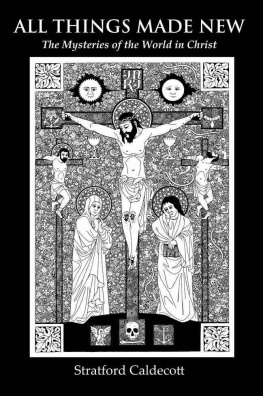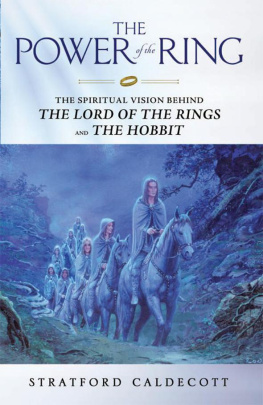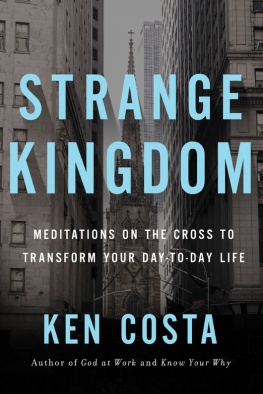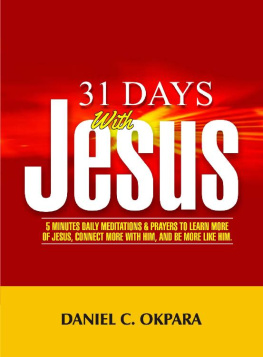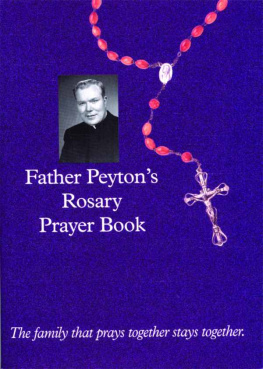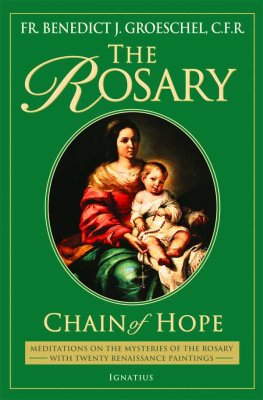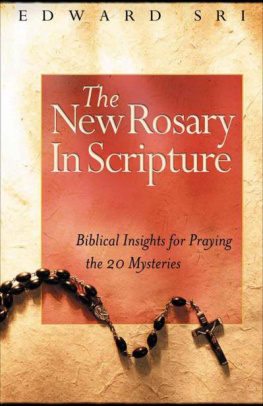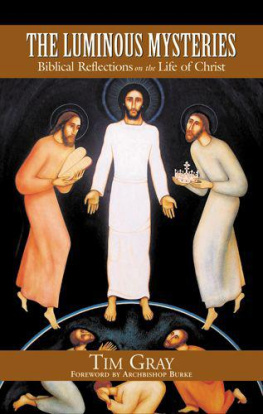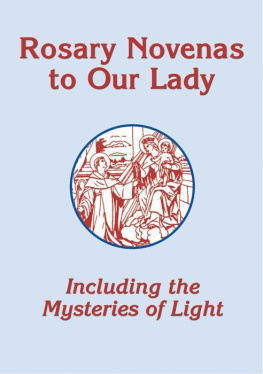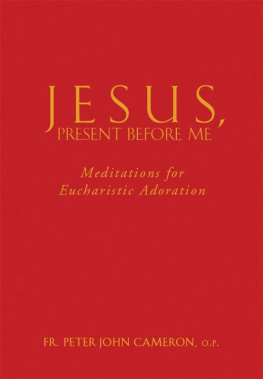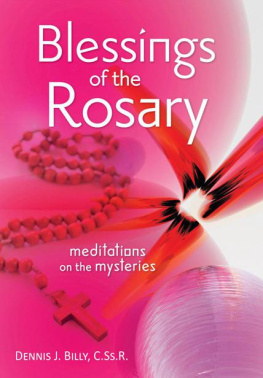ALL THINGS MADE NEW
THE MYSTERIES OF THE WORLD IN CHRIST
Stratford Caldecott
ALL THINGS MADE NEW
The Mysteries of the World in Christ

First published in the USA
by Angelico Press /Sophia Perennis
Stratford Caldecott 2011
All rights reserved
Series editor: James R. Wetmore
No part of this book may be reproduced or transmitted, in any form or by any means, without permission
For information, address:
Angelico Press /Sophia Perennis, P.O. Box 151011
San Rafael, CA 94915
angelicopress.com
sophiaperennis.com
Library of Congress Cataloging-in-Publication Data
Caldecott, Stratford.
All things made new: the mysteries of the world in Christ / Stratford Caldecott. 1st ed.
p. cm.
Includes bibliographical references.
ISBN 978-1-59731-129-8 (pbk: alk. paper)
ISBN 978-1-62138-009-2 (ebook)
1. Bible. N.T. RevelationCriticism, interpretation, etc.
2. Spiritual lifeCatholic Church. 3. SpiritualityCatholic Church.
I. Title
BS 2825.52.C35 2011
228.06dc22 2011018285
Front Cover: Crucifixion , ink drawing by Daniel Mitsui
www.danielmitsui.com
CONTENTS
To Lonie, who knows the mysteries better.
I NITIATION
This book continues and complements the exploration of the Christian mysteries I began in The Seven Sacraments , but you do not need that earlier book in order to read this one. That book was about the sacraments and the other patterns of seven mysteries that we find in the tradition, going back to the days of creation in Genesis. (You will find a summary in Appendix 5.)The present book is also concerned with Scripture, but opens with the last book in the canon, one of the most mysterious books of the Bible, the Book of Revelation also known as the Apocalypse of Saint John.
The Apocalypse provides a way in to the heart of the Christian revelation; it gives us our key to understanding both Bible and Tradition. It is about the end of the world, in the sense of the meaning or purpose of the world. For at the end of his life Saint John arrives at an End who is also a Beginning, the Alpha as well as the Omega. His vision of Jesus, the Son of Man, takes place on the Lords own Day, the Day of the Sabbath when God is at rest. It takes us back to Genesis and re-interprets everything. It is an unveiling of the mystery of the world in Christ himself.
Johns is a visionary book. In it we confront the Christian imagination firing on all cylinders. It takes us into the heart of theology, but this is theology in the original sensethat is, theology as it used to be understood in the Church before it became a purely academic subject, divorced from spirituality and prayer. Johns Apocalypse is a work of inspired visionary poetry, a kaleidoscope of images full of meaning, sparks thrown out by the impact of Christ. Its approach is the very opposite of rationalistic and moralistic. It does not start with commandments or a logical philosophy. It is more like a gushing stream or rising fountain of living water, from which we drink, perhaps at our peril.
An Outline of Mystagogy
The need for ongoing formation in the mysteries of Christ and of the Church, a catechesis traditionally known as mystagogia (initiation into the mysteries), has been noted in Catholic circles for years. Mystagogy is a technical term for the stage of exploratory catechesis that comes after apologetics, after evangelization, and after the reception of the so-called sacraments of initiation (Baptism, Eucharist, and Confirmation). While Baptism and Confirmation may be given only once, Christian initiation is a continuing adventure, since the new life of prayer must continue to grow, if it is not to wither and die. The Book of Revelation, I believe, encapsulates the mystagogia of the early Church.
The main focus of Catholic mystagogy today is on seven particular mysteries, called sacraments. The word is based on the Latin sacramentum , referring to consecration, which in turn was a translation of the Greek mysterion or mystery. The sacraments are therefore the Christian mysteries par excellence. The whole Christian mystery is, as it were, coiled up inside them. They are a kind of extension of Christs presence in the world. Their forms and even their number evolved over the centuries, but each leads us back to specific actions of Christ on earth, when he forgave, baptized, and blessed the men and women around him, and gave himself to them in the shape of food.
Each sacrament is a set of rituals and symbols that expresses an aspect of Christs life, and which is used by him to reach into our lives and transform us, provided we permit him to do so. In other words, they are symbols, but more than symbols: they are conduits of grace. In Baptism we are claimed for Christ, in Confirmation strengthened, in Confession reconciled, in Marriage joined to each other, in Ordination joined to Christ, in Anointing healed, and from the Eucharist, which is Christ, all these other sacraments receive their power.
The Church gave the sacraments a sevenfold form because each could then represent one of the seven days of creation, which were also the seven dimensions of the Old Covenant, and these can be seen to correspond with the seven primary needs of the human heart defined by Christ himself in the Lords Prayer. In this way the sacraments constitute a re-forging of the Covenant and the re-making of the world itself. The multiple sevens that readers can see in the Book of Revelation also reflect this underlying covenantal structure and emphasize its importance. Although in Johns time Christians may not have thought in terms of the seven sacraments, the reality they describe was already present.
Numbers were important for the early Christians for many reasons. They are, in a way, inherently mysteriouseven today philosophers cannot quite agree what they are, and why they seem to play such a vital role in the order of nature. Are they the thoughts of God? The ancient writers loved the patterns they made, and the simpler the better. Seven is made up of four and three. These numbers when multiplied give us twelve. Each of these numbers4, 3, 7is fundamental to Christian mystagogy and has multiple applications throughout the tradition.
Another important theme is introduced by one of the greatest Christian masters of mystagogy, who wrote under a pseudonym around five hundred years after the birth of Christ. Denys the Areopagite, sometimes called Saint Denys (he is also the patron saint of France, where he was thought to have been buried), is called in academic circles the Pseudo-Dionysius or Pseudo-Areopagite because he identified himself with the convert of Saint Paul mentioned in Acts 17:34. Denys divided the Christian Way into three phases called purification, illumination, and union, and linked these to three hierarchies of angels, who assist in each of these three phasesto put it another way, the active, inner, and contemplative life, reflecting a Trinitarian structure. His division can easily be integrated with other familiar Christian triads, such as the three Theological Virtues of faith, hope, and love, and the Evangelical Counsels which are familiar to many people as the three Vows taken by a monk or nun upon entering the consecrated religious life. The vow of poverty corresponds to purification, the vow of chastity to hope, and that of obedience (the integration of our will with Gods) to union.
Consistently with this tradition, the modern Catechism of the Catholic Church (paras 26992719) divides Christian prayer into three types: vocal prayer, meditation, and contemplation. These, too, can be seen as corresponding to Denyss three phases. Vocal prayer brings the body into line with the spirit by expressing the spiritual Word in voice and gesture. We can think of it as a kind of discipline that points us towards God. Meditation involves the imagination, the eyes of the heart, by which we penetrate gradually to the inner meaning of the words and images of faith. Finally, Contemplation is the prayer of silent union with God, a beginning or foretaste of the life of eternity.
Next page
